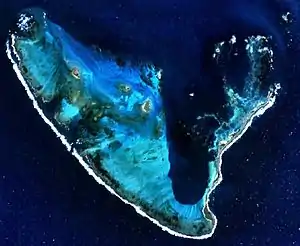Gun Island
Gun Island is one of the larger islands in the Pelsaert Group of the Houtman Abrolhos, in the Indian Ocean off the west coast of Australia. It is nominally at 28°53′10″S 113°51′35″E,[1] about 4 km (2.5 mi) north and east of Half Moon Reef and is a flat limestone outcrop of about 800 by 420 metres (2,620 by 1,380 ft) in size. The island is part of the Houtman Abrolhos Important Bird Area, identified as such by BirdLife International because of its importance for supporting large numbers of breeding seabirds.[2]
History
Between June 1727 and March 1728, crew of the Dutch VOC ship Zeewyk were stranded on the island after it struck Half Moon Reef. After a longboat with 11 seamen which had been dispatched to go for help had failed to return, the remaining survivors constructed a 20 metres (66 ft) sloop from the wreckage, which they named the Sloepie. Of the 88 who survived, 82 arrived in Batavia on 30 April 1728.[3]
During admiralty surveys of the north-west coast in 1840, the crew from HMS Beagle discovered a brass gun of about three pounds calibre and an iron swivel on which paint was still adhered. Captain Stokes with Commander John Clements Wickham named the place Gun Island.[4] They also discovered several coins, including one dated about 1707 and another dated 1720. Also seen was what appeared to be the beam of a ship with an iron bolt through it, and glass bottles and clay pipes. The material was presumed to have been left there by the Zeewyk castaways 112 years earlier.
In 1883, Charles Edward Broadhurst, who had been granted a lease for guano export, discovered several campsites and seal bones there, which had evidently been killed for sustenance by the Zeewyk crew.
Gun Island was one of the most heavily worked islands of the Abrolhos Islands for guano.[5] Guano workings continued on a commercial scale from the 1880s to the 1920s, and again in the mid-1940s. A 100 metres (330 ft) stone jetty built for loading guano on the south-eastern corner is intact.
A yacht, the Nautilus, was wrecked at Gun Island in 1897.[6]
A stratigraphic test well was drilled on Gun Island (28º53'30.11"S, 113º51'27.0"E) by BP Petroleum Development Australia in June–November 1968. It was drilled within the Perth Basin and reached a total depth (TD) of 3,725 m (12,221 ft).[7] The extent of the drilling platform near the wharf can be seen on satellite images.
Archaeology
An archaeological expedition by members of the Western Australian Museum was made to the island in 1974.[8]
Gun Island is classified as having 'High' conservation significance and is one of the seven protected zones in the Abrolhos Islands. Protected zone restrictions mean that "visitors shall not carry out any digging or major earthworks within the zones around declared maritime archaeological sites unless permitted to do so", and that they shall also not take metal detecting devices onto the island.[9]
A 20 metres (66 ft) wide rock called Gun Islet is about 30 metres (98 ft) off the southern tip of the island.
References
-
- Gazetteer of Australia (1996). Belconnen, ACT: Australian Surveying and Land Information Group.
- "Gun Island". Gazetteer of Australia online. Geoscience Australia, Australian Government.
- "IBA: Houtman Abrolhos". Birdata. Birds Australia. Retrieved 2011-08-12.
- Hugh Edwards (1970). The wreck on the half-moon reef. Rigby Limited, New York. ISBN 0684135507.
- Kimberly, W.B. (compiler) (1897). History of West Australia. A Narrative of her Past. Together With Biographies of Her Leading Men. Melbourne: F.W. Niven. p. 15
- "Zeewijk". VOC Shipwrecks. Archived from the original on 2007-09-27. Retrieved 2007-12-02.
- "Abrolhos Islands Shipwrecks". Retrieved 2007-12-02.
- R.D. Hawkins (1969). Gun Island No.1 Completion report. BP Petroleum Development Australia Pty. Ltd.
- "Zeewijk". Western Australian Museum. Archived from the original on 2007-09-26. Retrieved 2007-12-02.
- "Inventory of the land Conservation Values of the Houtman Abrolhos Islands" (PDF). Department of Fisheries. October 2003. ISSN 0819-4327.
